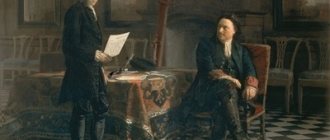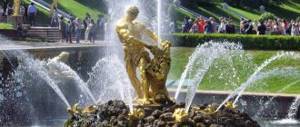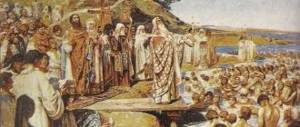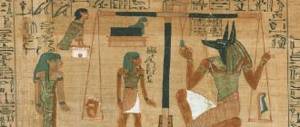In 1689, Peter Alekseevich (Peter I) established himself on the Russian throne, gaining the opportunity to make independent decisions, and not just be listed as king. Since 1682, due to their young age, together with their brother Ivan, they were rulers under the regency of their elder sister Sophia. In history this phenomenon is called dual power. Descendants remembered him as a controversial and powerful man who started global transformations in the country. These historical reforms will be discussed in our article.
The material was prepared jointly with a teacher of the highest category
Alexandrova Ekaterina Valerievna.
Experience as a history and social studies teacher - 11 years.
Conditions for change
Having gained true power, the king immediately began to govern the country. There are several main reasons for this:
- he inherited a state that was quite far behind the European powers in economic development;
- he understood that such large and poorly developed territories needed constant protection and the establishment of new economic and political ties.
In order to adequately support the army, it is necessary to raise the standard of living of the entire country, change foundations and strengthen power. This became the main goal and objectives of the reforms of Peter the Great.
Not everyone liked the innovations of Peter I. Some segments of the population tried to resist the reforms of Peter the Great. The boyars and high clergy lost their special status, and a small group of nobles and merchants were afraid to deviate from old customs. But due to the lack of sufficient support, they could not stop the changes, only slowing down the process.
Rice. 1. The first Russian emperor Peter the Great.
Establishment of the Senate
Finally, by Decree of March 2, 1711, a new government body was created - the Senate. Initially, the Senate consisted of 9 of Peter’s closest employees. It was the highest state authority. To control management in 1711, Peter created a system of fiscals, which were subordinate to the chief fiscal. Their duties: to report to the Senate and the Tsar about the abuses and dishonest actions of officials. Fiscals received half of the property of the culprit if their denunciation was confirmed. This is where the legs of modern corruption come from!
But in 1722, the position of prosecutor general was introduced - to manage the fiscal authorities. The Prosecutor General was supposed to oversee the Senate, thereby reducing the role of the Senate. Peter took the Swedish government system as a model for the reform of public administration, which was built on the principles of cameralism (organization of an institution based on collegiality, regulation of the activities of officials, uniformity of staff and salaries). But someone else's experience can never be completely transferred to another soil. Peter also made changes due to the peculiarities of Russia, by Decree of April 28, 1718:
“All boards must now, on the basis of the Swedish statute, draw up points in all cases and procedures, and which points in the Swedish regulations are inconvenient, or are dissimilar to the situation of this state, and put them according to their own judgment. And, having stated about them, report whether they are so.”
The essence of the transformation
State reforms in Russia during the time of Peter I can be conditionally divided into two stages:
TOP 4 articles that are read along with this
- 1. Military reform of Peter 1
- 2. Reforms of Peter 1 (table)
- 3. The era of palace coups briefly
- 4. Peter's economic reforms
- From 1696 to 1715: changes were carried out hastily, under pressure; were poorly thought out and often ineffective. The main activities of this period were aimed at obtaining resources for participation in the Northern War.
- From 1715 to 1725: the transformations were planned and were more successful.
In 1698, Peter the Great, having adopted the experience of Western Europe, began to actively transform both the state and public spheres. For convenience, we will list the main changes point by point:
- Administrative : include public administration reform, regional (provincial), city. Creation of new authorities (Senate, 13 colleges, Holy Synod, Chief Magistrate); changing the territorial structure (dividing Russia into 8 provinces and 50 provinces) for more efficient management;
- Judicial reform : also concerned the reorganization of power, but is highlighted separately, since its main task is to stop the influence of the administration on judges;
- Church reform : deprivation of the church's independence, submission to the will of the ruler;
- Military reform : creation of a fleet, a regular army thanks to the introduction of conscription, their full support;
- Financial : includes monetary and tax reforms. The introduction of new monetary units, reducing the weight of coins, replacing the main tax with a capitation tax;
- Industrial and trade reforms : mining, creation of manufactories, use of serfs to reduce the cost of labor (such peasants were called sessional), state support for national production, reducing imports, increasing exports;
- Social : class reforms (new duties for all classes), educational (compulsory primary education, creation of specialized schools), medical (creation of a state hospital and pharmacies, training of doctors). They also include educational reforms and changes in the field of science (the creation of the Academy of Sciences, printing houses, a public library, the publication of a newspaper), including metrology (the introduction of English units of measurement, the creation of standards);
- Cultural : new chronology and calendar (the year begins on January 1), the creation of a state theater, the organization of “assemblies” (mandatory cultural events for nobles), restrictions on wearing beards (beard money was introduced for those who wanted to keep a beard), European requirements for clothing, permission to smoke.
The nobility was seriously indignant at the need to bring their appearance in line with European standards.
Rice. 2. Boyars under Peter II.
Traditional orders and serfdom in the context of the deployment of modernization
Many traditional orders were revised and abolished. At the same time, wearing Western dress (for nobles), shaving beards, celebrating the New Year (from January 1, 1700), etc. became mandatory.
Changes were taking place in industry. The number of manufactories increased significantly, new industrial regions began to form: the Urals, St. Petersburg. Among individual industries, the greatest successes were achieved by metallurgy (Ekaterinburg, Nizhne-Tagil, Kamensk-Ural plants) and textile industry (Moscow Cloth Yard, Bolshaya Yaroslavl Manufactory). New industries began to develop, such as shipbuilding (Arkhangelsk, St. Petersburg), silk spinning, glass and earthenware production, and paper production.
The development of industry was hampered by the presence of serfdom. Craftsmen from abroad, soldiers, convicts, and runaway peasants were invited to the enterprises, but there was a catastrophic shortage of free labor. In 1721, a decree appeared that allowed factory owners of non-noble origins to buy and resettle peasants to their enterprises. Such peasants were called possessions. Such steps contributed to the rapprochement of manufactories with serf estates. They practically did not use hired labor. The largest Russian industrialists (Demidovs, Stroganovs, Myasnikovs) eventually received titles of nobility, forming the backbone of the emerging national bourgeoisie.
Peter's reforms had little impact on the state of agriculture. Among the positive aspects, it is worth noting the continuation of the process of development of agricultural land in the Volga region, Siberia and the south of the country. More land began to be allocated for industrial crops (tobacco, flax, hemp). Some success has been achieved in developing new breeds of livestock. However, the agricultural sector continued to develop in an extensive way, in which the main method of increasing productivity was the strengthening of serfdom. Each landowner himself determined the amount of duties imposed on the peasants. In 1724, the emperor issued a Decree prohibiting peasants from going to work without receiving written consent from their landowner.
The dominance of serfdom from time to time caused powerful popular uprisings: the uprising of archers and peasants in Astrakhan (1705-1706); the performance of the Cossacks on the Don under the leadership of Kondraty Bulavin (1707-1708) - the participants in the uprising demanded the preservation of Don liberties and the old order on the Don; unrest in Bashkiria (1705-1711).
The result of Peter I's reforms was the emergence of absolutism. The military power of the state increased noticeably, the formation of the nobility and the general “Europeanization” of Russia accelerated. At the same time, the confrontation between the top and bottom of society intensified, serfdom increasingly resembled a form of slavery.
Consequences of reforms
It would be wrong to downplay the importance of the reorganizations carried out by Peter I. They contributed to the comprehensive development of the Russian state, which made it possible to make it an empire in 1721. But we should not forget that not all results were positive. The transformations led to the following results:
- Strengthening power with the help of a new state apparatus (strengthening autocracy);
- Construction of the fleet, improvement of the army, gaining access to the Baltic Sea, the consequence of which was an increase in the international authority of Russia (but due to the introduction of conscription - the service lasted 25 years);
- Protectionism - protection and development of domestic industry (use of free labor of serfs);
- Improving conditions for the development of science and education (practically did not concern the common people);
- Spread of European culture (oppression of national traditions);
- Payment of a noble title for service merits in accordance with the Table of Ranks (additional duties for all segments of the population);
- Introduction of new taxes (non-Russian peoples - Bashkirs, Tatars - were especially taxed).
Large-scale construction led to considerable casualties, since most of the workers did not have the necessary experience.
Rice. 3. Construction of St. Petersburg.
Summary of the lesson “Reforms of Peter I” in history
Lesson Plan- Central government reform.
- Regional reform.
- City government reform.
- Table of ranks. Decree on unified inheritance .
- Speeches against reforms. "The Case of Tsarevich Alexei."
- The meaning of Peter's transformations.
§ 15. Reforms of
Peter I.
- Central government reform.
(Teacher's story)
The 18th century was a time of major changes in the economy, politics, social relations, and public life of Russia. Already the beginning of the century was accompanied by a sharp leap “into the future” with the emergence of innovations and the destruction of old foundations.
— Let's reveal the reasons for the reforms of Peter I.
(Guys, what caused Peter’s transformations?)
According to A.S. Pushkin: “Russia entered Europe like a ship launched from the stocks - with the sound of an ax and the thunder of cannons.”
The creation of a new army and navy, a radical reform of industry, rapidly developing contacts with foreign countries, the need to obtain more and more new funds for the needs of the state and the needs of war required clear, fast, coordinated work of all government units. And most importantly, the growing autocratic power of the tsar, who, thanks to his indomitable energy, took part in literally all spheres of the country’s life, needed a state machine obedient to his will, where his subjects would unquestioningly and zealously carry out the tsar’s decrees and instructions.
Already at the end of the 17th - beginning of the 18th centuries. he stopped convening the Boyar Duma, introduced the Near Chancellery instead, appointed his comrades-in-arms there as ministers, and increasingly entrusted the governance of the country to loyal supporters. But already at this time he began to put them under his strict control. In 1707, Peter I, being in the active army, ordered that the members of this “office” must write down their speeches and sign them in their own hand, “for by this (i.e., by this) all stupidity will be revealed.” He transferred this principle to the work of the new institution, which after the tsar became the supreme governing body of the country.
In 1711,
Setting off on the Prut campaign,
Peter I created the Governing Senate,
which he entrusted with governing the country in his absence. At first he included nine of his trusted representatives there. In his order to the Senate, Peter defined its responsibilities as the highest judicial, executive and partly legislative body. There was no talk of any separation of powers here. Among the responsibilities of the Senate were the following: “To have an impartial court and to punish unjust judges by taking away honor and property,” “To look at the entire state’s expenses,” “To collect money as much as possible, since money is the artery of war.”
But simultaneously with the new supreme body of power in the country, which replaced the Boyar Duma and was completely subordinate to the tsar, Peter introduced the positions of fiscal officers, starting from the chief fiscal officer of the Senate and ending with fiscal officers in other central institutions, as well as locally. The task of the fiscals was to control the entire administration and identify cases of violation of laws, bribery, and embezzlement. They reported directly to the tsar, but did not receive a salary, but subsisted on first half, and later one third, of the property confiscated from bribe-takers and embezzlers. It is clear that the fiscals, encouraged by the tsar, showed great agility in their work.
There was also a high controller over the Senate - the Prosecutor General and his assistant Chief Prosecutor. There were prosecutors in other institutions as well. They were the real “eye of the sovereign” and obeyed only the king. If the Attorney General saw a violation or negligence in the actions of the Senate, he could suspend and protest them. The first Prosecutor General of the Senate was the closest associate of Peter I, Pavel Ivanovich Yaguzhinsky.
Since 1718
.
instead of orders, so-called collegiums began to be gradually introduced.
By 1720 there were 11 of them. These were the highest administrative institutions with a strict and clear division of functions. In the sphere of activity of each board, power extended over the entire country. So, the Military Collegium was in charge of the army, the Admiralty Collegium was in charge of the navy, and the Foreign Collegium was in charge of international affairs. The Manufactory and Berg Collegiums, responsible for the development of industry and mining, have already been mentioned above. Finance was in charge of the Chamber Collegium, control over the collection and expenditure of funds was in charge of the Revision Collegium, the organization and work of the courts was in charge of the Justice Collegium, and trade was in charge of the Commerce Collegium.
Each board consisted of a president, vice-president, advisers and assessors (from the Latin “assessor” - “assessor”). They worked every day. For their work, members of the boards received a salary and thus became government officials wholly dependent on the tsar. The work of the boards, like other institutions in the country, was also closely monitored by fiscal officials.
In 1721, Peter I established the highest body for managing church affairs - the Synod. This is a natural step. After the death of the patriarch, Peter left this position unoccupied. He could not forgive the opposition churchmen in the matter of his reforms. Now the Synod has essentially become a spiritual college. It was composed of church hierarchs appointed by the king. The church was finally subordinated to the state.
Peter paid great attention to the organization of political investigation. At first, this was done by the Preobrazhensky Order. Later, the king established the Secret Chancellery, which was somewhat reminiscent of the order of the Secret Affairs of his father. All the information from the royal spies and informers flocked here. Here investigations and reprisals were carried out in political cases in which the tsar himself took an active part.
2. Regional reform.
The tsar also built local government to match this. Peter in 1708-1710
gg. divided the entire country into 8 (later - 11) provinces (Moscow, St. Petersburg, Siberian, etc.) - large territorial-administrative divisions, headed by governors-general (in the largest provinces) and governors. There were troops in every province. Governors had enormous power - administrative, police, judicial, financial. The tsar's favorite, Prince A.D. Menshikov, was placed at the head of the St. Petersburg province.
Later it turned out that in such vast territories, power hardly reaches the Russian hinterland, and Peter created a new local management network; all provinces were divided into provinces. There were 50 of them in Russia. And they, in turn, were divided into districts. Governors were also at the head of large provinces, and voivodes were at the head of the rest. The name remained the same, but the essence of the governor’s power changed radically. Now they are no longer semi-independent kings in their territories, but government servants under control, in charge of the entire administration of the provinces and answerable to the king for their actions. At the head of the districts were zemstvo commissars, and they, in turn, controlled the activities of rural sotskys and tens. All of Russia, therefore, was organized according to bureaucratic rank, with a clear division of managerial responsibilities.
3. Urban government reform.
New management was also introduced in cities. All cities in the country were in charge of the Chief Magistrate. Each city had its own magistrates. The urban population obeyed them and was excluded from the jurisdiction of the governor. The magistrates were chosen from among wealthy city residents - merchants, entrepreneurs, wealthy artisans, and local intelligentsia. They became the only elected bodies in Russia.
An important part of the country's management system were profit-makers - special people appointed by the tsar, whose task was to replenish the treasury through more and more taxes. And the profit-makers tried their best. The government imposed taxes on everything that profit-makers pointed out to it. It got to the point that duties were introduced for those who wore a beard and mustache. The tax was levied on oak coffins and house frames, and even home baths. True, Peter 1 later abolished this strange tax.
4. Table of ranks. Decree on unity of inheritance.
Petrine reforms of the Russian government were crowned with the publication in 1722 of the Decree “Table of Ranks”
. From now on, the entire Russian official bureaucratic world is divided into 14 categories - from the actual state councilor and chancellor (1st category) to the college registrar (14th category). The same division was introduced in the army and navy - from generalissimo, general field marshal, general and admiral (1st rank) to cornet and ensign (14th rank).
Each had a corresponding salary and position in society. Those who received ranks of the 14th - 9th ranks became nobles, but could not pass on the title of nobility by inheritance. Those who reached the 8th rank received hereditary nobility. In the army, those who reached the 12th grade achieved the same thing.
Thus, in the civil service system and promotion to positions, personal merits and merits, devotion to the sovereign, length of service, etc. came to the fore. “Breed” as a basis for occupying positions finally came to naught.
Part of the general restructuring of the state system in Russia included significant changes in the position of the estates. The estates acquired a clearer character; they seemed to be integrated into the overall system of governing the country. Thus, the townspeople were divided into “regular”, who had the right to vote, and “irregular”, “mean people” who did not have the right to elect magistrates. Craftsmen were organized into workshops by profession.
In addition, all “regular” townspeople were divided into guilds according to their status. The first guild included rich people, the second - poorer people.
In the interests of the nobility, Peter I, with his Decree of 1714 “On Single Inheritance,” firstly, eliminated the difference between votchina and estate. Now landowners, like patrimonial owners, had the right to full ownership of their estate, but subject to service with the sovereign. They could pass on their possessions by inheritance, sell, buy, or mortgage them. This led to the stabilization and rise of the landowner economy. The landowners, no longer afraid of losing their estates, began to invest more labor in the economy.
Secondly, by the same decree, Peter I introduced the rule of inheritance of estates by only one of the heirs. This, first of all, stopped the fragmentation of estates. In addition, the remaining sons, having no means of subsistence, had to go into public service, into the army. Thus, the king received additional personnel in all areas of the country's life.
5.
Opposition to reforms.
"The Case of Tsarevich Alexei." Peter's reforms were rejected by many, mainly by the patriarchal aristocracy, who saw in them the destruction of their traditional world.
Those dissatisfied with the reforms needed a leader. If earlier this was the Tsar’s sister, Sophia, then after her imprisonment in a monastery, all the dissatisfied began to group around the Tsar’s son Alexei
, brought up in the ancient traditions of the Moscow court.
The differences between father and son became increasingly obvious. Fearing for his fate, Alexey fled from Russia to Austria in 1716, where he tried to seek support in the fight against his father. Through the efforts of Peter the Great’s diplomat and the future head of the Secret Chancellery, Count P. A. Tolstoy
the fugitive was returned and brought to justice. Under torture, he confessed to a conspiracy against the tsar and was sentenced to death, but under unclear circumstances he died in prison.
Peter constantly thought about the fate of the reforms he was carrying out. The “case of Tsarevich Alexei” prompted him to change the order of succession to the throne. In 1722, a decree was signed according to which the king could appoint any successor for himself, regardless of the degree of relationship. However, Peter never had time to do this. Having caught a cold in January 1725, he died suddenly.
6. The significance of Peter's transformations.
The government reforms carried out by Peter I were of great importance for the country. The creation of a regular army and navy strengthened the country's security and helped solve pressing foreign policy problems.
The reforms significantly strengthened the Russian state and placed it among the great European powers.
They changed the remnants of localism remaining from appanage Rus', erasing the lines in both the economic and official position of the boyars and nobility.
They improved the system of local government, introducing elective principles in city management for the first time in the history of the unified Russian state.
The church finally turned into one of the state instruments.
At the same time, the new system of governing the huge country continued to deprive millions of ordinary subjects of the Russian emperor from participating in deciding their fate.
Thus, Russia has taken a significant step towards integration into the European system. However, under Peter I, elements of the eastern type of civilization also intensified in Russia. The state apparatus and bureaucracy have crushed all classes and social groups, blocking the path for the formation of the rudiments of civil society. There was a complete enslavement of those sections of society that had remained free in previous eras. The huge public sector created by Peter I became the main obstacle to the formation of market relations in industry. As a result of Peter's reforms of the state apparatus and local authorities, an absolutist bureaucratic state was created in Russia.







